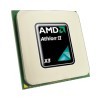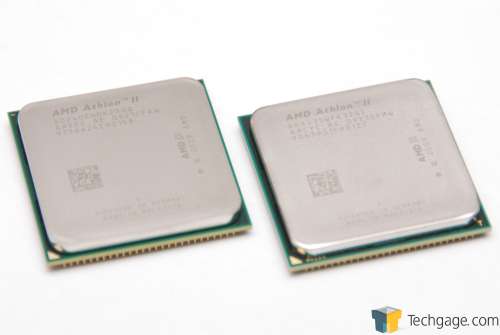- Qualcomm Launches Snapdragon 4 Gen 2 Mobile Platform
- AMD Launches Ryzen PRO 7000 Series Mobile & Desktop Platform
- Intel Launches Sleek Single-Slot Arc Pro A60 Workstation Graphics Card
- NVIDIA Announces Latest Ada Lovelace Additions: GeForce RTX 4060 Ti & RTX 4060
- Maxon Redshift With AMD Radeon GPU Rendering Support Now Available
AMD Athlon II X2 240e & X3 435

If on the lookout for a budget processor, whether it be dual, tri or quad-core, there’s no better place to look than AMD. The company recently released eight new models, and in total, nine current Athlon II’s retail for under $100. We’re taking a look at two such models here, the X3 435 and X2 240e, to see how much bang can be had for so little buck.
Page 1 – Introduction
This past October, AMD accomplished a world’s first. It became the first company to release a sub-$100 quad-core processor to the market, and given how much Intel has been dominating the CPU landscape as of late, it was great to see the green team at least attempt at hitting Intel hard in the budget CPU market. As we saw in our article, the Athlon II X4 620 is certainly a capable CPU, and for the price, it’s hard to beat.
We’ve been seeing the same thing out of AMD for a while. Intel undoubtedly dominates the mid-range and higher market, but AMD is the more willing of the two to deliver great parts at the low-end for very affordable prices. As it stands today, while Intel’s lowest-priced quad-core is $163 (Q8200), AMD offers four under that, the X4 600e, 605e, 620 and 630. The same applies to AMD’s dual and tri-core, though. Clock speeds are high, but not the prices.
In late October, AMD followed-up to its $99 quad-core with a slew of other Athlon II models, which included even more quad’s, some tri’s and of course, some dual-cores. Two of these launch CPUs are what I’m taking a look at here, the X2 240e and X3 435. Both are priced well below $100, but offer nice frequencies and features. Is AMD’s latest line-up the be-all end-all for budget parts?
Closer Look
Of the eight new processor models AMD released in October, two are dual-core, four are tri-core and two are quad-core, and of all these, six are part of the company’s power efficient line. CPUs belonging to this have an “e” at the end of the model to denote the fact, and currently, all “e” models are rated for 45W, while the rest is 95W for the tri’s and quad’s, and 65W for the dual’s. You can see AMD’s entire current Athlon II line-up below:
|
CPU Name
|
Cores
|
Clock
|
Cache (L2/L3)
|
HT Bus
|
Socket
|
TDP
|
1Ku Price
|
| AMD Athlon II X4 630 |
4
|
2.8GHz
|
2MB/0MB
|
4000MHz
|
AM3
|
95W
|
$122
|
| AMD Athlon II X4 620 |
4
|
2.6GHz
|
2MB/0MB
|
4000MHz
|
AM3
|
95W
|
$99
|
| AMD Athlon II X4 605e |
4
|
2.3GHz
|
2MB/0MB
|
4000MHz
|
AM3
|
45W
|
$143
|
| AMD Athlon II X4 600e |
4
|
2.2GHz
|
2MB/0MB
|
4000MHz
|
AM3
|
45W
|
$133
|
| AMD Athlon II X3 435 |
3
|
2.9GHz
|
1.5MB/0MB
|
4000MHz
|
AM3
|
95W
|
$87
|
| AMD Athlon II X3 425 |
3
|
2.7GHz
|
1.5MB/0MB
|
4000MHz
|
AM3
|
95W
|
$76
|
| AMD Athlon II X3 405e |
3
|
2.3GHz
|
1.5MB/0MB
|
4000MHz
|
AM3
|
45W
|
$102
|
| AMD Athlon II X3 400e |
3
|
2.2GHz
|
1.5MB/0MB
|
4000MHz
|
AM3
|
45W
|
$97
|
| AMD Athlon II X2 250 |
2
|
3.0GHz
|
2MB/0MB
|
4000MHz
|
AM3
|
65W
|
$69
|
| AMD Athlon II X2 245 |
2
|
2.9GHz
|
2MB/0MB
|
4000MHz
|
AM3
|
65W
|
$64
|
| AMD Athlon II X2 240 |
2
|
2.8GHz
|
2MB/0MB
|
4000MHz
|
AM3
|
65W
|
$60
|
| AMD Athlon II X2 240e |
2
|
2.8GHz
|
2MB/0MB
|
4000MHz
|
AM3
|
45W
|
$77
|
| AMD Athlon II X2 235e |
2
|
2.7GHz
|
2MB/0MB
|
4000MHz
|
AM3
|
45W
|
$69
|
As the above table shows, AMD offers a wide-range of budget processors for the taking, with nine of of the thirteen priced at under $100. Like the Athlon II X4 620 we delved into back in October, no Athlon II model includes L3 Cache like the Phenom II’s do, and as a result, certain scenarios will turn out to be a bit slower, like video encoding and in some cases, gaming. But, that’s a small price you have to pay in order to get such an affordable model.
It’s important to note that the energy-efficient models, as you’d expect, sell for higher prices than the non-“e” chips do. The only current case where there’s both a regular and “e” version of the same chip is with the 240, and as you can see, there’s a $17 premium over the non-“e”, or about +28%. This isn’t a major premium, but the 65W > 45W change is a small one, and results seen in the real-world aren’t going to be quite so high. If the choice came down to one or the other, I’d quicker recommend just picking up a faster model, only buying the “e” if you are really passionate about power-efficiency.
Because we’re dealing with very low-end processors throughout this article, I’ve opted to not overclock them, both due to what I see as a lack of need, and also because of a real lack of time. The vast majority of consumers purchasing these processors aren’t going to be overclocking them, and if overclocking is in the cards, or chips rather, I’d highly recommend splurging for a faster CPU to begin with, such as a Phenom II, or the X4 620 if what you really crave is improved multi-tasking.
So with that said, let’s get right into the look at our test systems, followed by our results.
Support our efforts! With ad revenue at an all-time low for written websites, we're relying more than ever on reader support to help us continue putting so much effort into this type of content. You can support us by becoming a Patron, or by using our Amazon shopping affiliate links listed through our articles. Thanks for your support!






